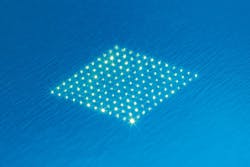Laser cutting enables intricate plug connector designs
Researchers at the Fraunhofer Institute of Laser Technology (Fraunhofer ILT; Aachen, Germany) have shown that helical drilling with ultrashort-pulse (USP) lasers is an excellent option for drilling high-aspect-ratio precision micro-holes in steel, glass, and ceramic. Precision is one of the greatest strengths of helical drilling, so the researchers questioned whether this method could also be used for cutting sheet metal parts and, if so, whether the speed of the process could be increased to make it suitable for production purposes.
This prompted the launch of ScanCut, a collaborative project involving KOSTAL, Fraunhofer ILT, and the companies Amphos GmbH and Pulsar Photonics GmbH, both based in Herzogenrath, Germany. The project was funded by the European Regional Development Fund (ERDF) and the state of North Rhine-Westphalia.
“In the project, we combined our helical drilling optics with a multi-beam module from Pulsar Photonics GmbH and a high-power beam source from Amphos GmbH,” says Jan Schnabel, scientist in the Micro and Nano Structuring group at Fraunhofer ILT. “That allowed us to combine the precision and quality of the helical drilling process with the productivity of multi-beam processing.”
Amphos GmbH developed a high-power beam source based on InnoSlab technology, with an output power of 300 W and a pulse energy of 3 mJ. The high pulse energy is necessary to divide the laser beam into as many as 20 individual beams. First, however, the project partners focused on verifying whether the multi-beam method worked by splitting the laser beam into two to six separate beams.
A follow-up project is now planned in which Pulsar Photonics GmbH and Fraunhofer ILT will continue developing the helical cutting technology with a multi-beam module. The insights obtained from the project will also be used to develop high-power beam sources to expand the portfolio of products offered by Amphos GmbH.
The project partners focused in particular on the possibility of automation. “We implemented electrically adjustable mirror and optics mounts to enable automatic adjustment of the beam position,” says Schnabel. “Once we have programmed a suitable software routine, adjustments to the helical drilling optics can be initiated at the touch of a button without any of our staff having to travel to the site.”
The three-year ERDF project “ScanCut – Laser cutting in the stamping process” was completed in February 2020.
